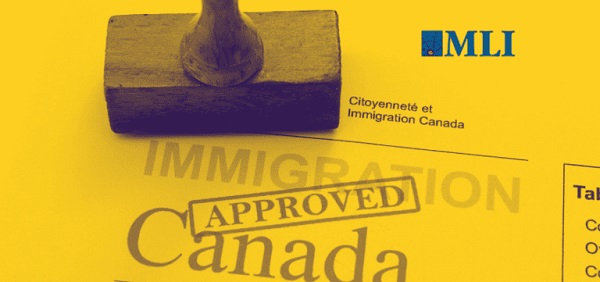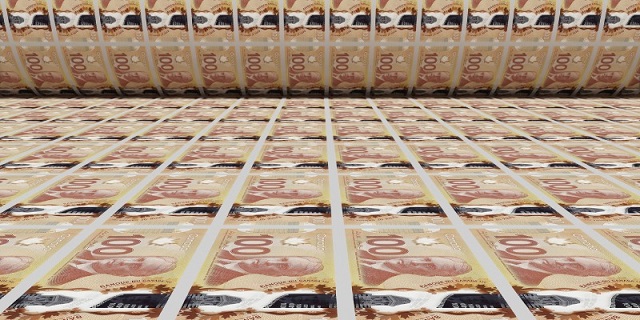Economy
Federal mismanagement to blame for Canada’s immigration backlash

From the Macdonald Laurier Institute
By Sonia Orlu for Inside Policy
Canada’s welcoming attitude towards newcomers makes it one of the most sought-after places to live in the world. However, this image is being tested by a growing backlash against immigration. Immigrants make up 23 per cent of the population, yet economic, social, and cultural anxieties are increasingly challenging the country’s commitment to diversity. More than four-in-ten Canadians now agree – either strongly (23 per cent) or somewhat (21 per cent) – with the statement, “There is too much immigration to Canada.” It is crucial to understand that this backlash is not rooted in opposition to immigration or immigrants themselves, but rather in frustration over mismanagement and inadequate planning by the federal government. It reflects a growing unease about the country’s economic outlook, raising urgent questions about how Canada can uphold its values while addressing legitimate and pressing concerns.
Public reactions and political responses
Canadian political leaders have generally maintained a measured tone on immigration, focusing on economic pressures and service delivery rather than hostility toward immigrants. However, tensions are rising, and a thoughtful debate is increasingly needed.
Prime Minister Justin Trudeau has accused the Conservative Party of spreading misinformation to stoke fears about immigration. Such remarks risk alienating those with legitimate critiques of his administration’s policies and practices. Conservative Leader Pierre Poilievre has linked immigration to housing shortages, criticizing Trudeau’s policies as disconnected from infrastructure needs. This aligns with public frustrations over housing availability and the need for better coordination between immigration levels and capacity. Quebec Premier François Legault echoed similar sentiments, raising issues of resource management and culture. His critics accuse him of xenophobia, but dismissive responses like Immigration Minister Marc Miller’s remark that people are “always blaming immigrants” overlook genuine challenges and deepen frustration.
These exchanges illustrate the delicate balance required in navigating immigration policy and public sentiment. Canadians’ attitudes toward immigration are more nuanced than a simple pro- or anti-immigration divide. Most Canadians aren’t driven by fear or racism; rather, they are focused on how immigration impacts housing affordability, strains public finances, and increases job competition. While apprehension about immigration levels is growing, attitudes toward immigrants themselves remain largely positive. In fact, more than four-in-ten Canadians (42 per cent) say that immigrants make their community a better place, with fewer than one-in-ten (9 per cent) feeling that they make it worse. Still, public concerns must be addressed to prevent further polarization.
The housing crisis: a catalyst for frustration
A significant driver of the immigration backlash is the housing crisis. The Canada Mortgage and Housing Corporation (CMHC) reported in 2024 that Canada needs an additional 3.5 million housing units by 2030 to restore affordability. Cities like Toronto and Vancouver have seen housing prices soar, partly due to increased demand from population growth.
The “housing theory of everything” highlights how housing affects multiple societal issues – such as economic inequality, social mobility, and political polarization. Immigration is no exception. Housing shortages drive up costs, deepen inequality, and create competition between immigrants and long-term residents, eroding social trust and cohesion.
The rise in temporary residents, including international students and temporary foreign workers, compounds these issues. Immigration, Refugees and Citizenship Canada (IRCC) reports that the number of temporary residents increased by over 50 per cent from 2017 to 2022 and continued to rise sharply into 2024. This influx contributes to increased demand in the rental housing market, particularly in urban centres with large universities, driving up prices and reducing availability.
The Trudeau government’s ambitious plan to admit nearly 500,000 new permanent residents annually by 2026 marks one of the highest per-capita immigration rates globally. By comparison, Canada admitted around 200,000 landed immigrants per year in the 1990s and 250,000 per year in the early 2010s. Without matching investments in infrastructure and housing, these elevated immigration levels – often referred to as “mass immigration” – could exacerbate housing shortages, strain public services, and heighten public frustration. Internal documents from Immigration, Refugees, and Citizenship Canada revealed that as early as 2022, officials warned that large increases in immigration could worsen housing affordability and strain public services. Yet, no substantive steps were taken by the government to revise its targets.
Given the realistic timelines for development, it is improbable that infrastructure can keep pace with rapid population growth. The construction industry faces labour shortages, regulatory hurdles, and lengthy timelines for project completion – often several years. The CMHC maintains that due to these complexities, expecting cities to rapidly scale up infrastructure to meet immediate demands is unrealistic.
If these housing issues are not resolved, public frustration could escalate, potentially shifting from concerns about immigration policy to resentment toward immigrants themselves.
Cultural integration: balancing diversity and cohesion
Economic challenges, such as housing affordability, often intersect with social and cultural anxieties. As communities experience rapid change and strained resources, questions arise about society’s ability to integrate newcomers without compromising its social fabric. While only about 4 per cent of Canadians express fears that immigration weakens local culture and identity, concerns about the effectiveness of integration are more widespread. In fact, approximately half of Canadians are concerned that some immigrants may not be adopting Canadian values or fully participating in the broader community. When asked which values immigrants should adopt, Canadians often prioritize language proficiency and respect for the country’s history and culture, highlighting the importance placed on cultural integration. Interestingly, both native-born and foreign-born Canadians largely agree on the values newcomers should embrace, indicating a shared vision for integration.
Canada’s sense of nationhood is deeply tied to its history of migration and its commitment to cultural and ethnic diversity. However, diversity is not inherently beneficial in all forms; its value depends on whether it leads to greater tolerance, creativity, or economic growth. When cultural and ethnic diversity is celebrated without deliberate efforts to foster interaction and promote unity, it risks becoming fragile. Poorly managed diversity can lead to social fragmentation, lower trust, and weakened civic engagement.
The challenges of integration are well-documented. Language barriers, different social norms, and unfamiliarity with Canadian institutions can make it difficult for immigrants to fully integrate. This can sometimes lead to the formation of cultural enclaves, where newcomers find comfort in communities with shared backgrounds but have limited interaction with the broader society. While these enclaves provide crucial support, they can inadvertently hinder full participation in Canadian life. Sociologist Robert Putnam found that, in the short term, diversity can reduce social capital and lower community engagement, particularly when institutions fail to promote integration – a concept he refers to as “hunkering down.” In such cases, both newcomers and long-term residents may feel isolated.
Despite these challenges, diversity, when managed effectively, can yield benefits. Exposure to different cultures fosters creativity, innovation, and economic growth, even though research suggests that immigration itself is neither inherently good nor bad for the economy. Cities like Toronto and Vancouver have thrived in part due to their multicultural populations, which have helped them become global hubs for technology and the arts. Additionally, evidence shows that successful integration is common in Canada. Many immigrants actively embrace Canadian values, contribute to the economy, and participate in civic life. The majority of eligible immigrants become Canadian citizens, demonstrating a strong commitment to their new country. Many immigrants choose Canada precisely because they align with its principles of democracy, equality, and respect for human rights. Cultural integration, in the end, is a dynamic process – one that, when approached thoughtfully, strengthens rather than weakens the social fabric.
Bridging policy failures with sustainable solutions
Addressing public frustrations with immigration requires a serious reassessment of the policies that have exacerbated these concerns.
First and foremost, tackling the housing crisis through integrated planning is essential. Governments should incentivize affordable housing development and reform zoning laws to allow for higher-density projects. Recognizing the realistic timelines for construction and development, planning must begin immediately and be synchronized with immigration targets. Public sentiment strongly supports this approach. A recent Nanos Research survey found that 72 per cent of Canadians want to reduce immigration levels until housing becomes affordable.
Aligning immigration levels with the country’s capacity is crucial. Dynamic targets based on real-time economic data and infrastructure development would ensure that immigration aligns with Canada’s ability to provide services and opportunities. Returning to historical admission levels of 200,000 to 250,000 immigrants per year could help ease pressure on housing and public services. Adjusting the composition of immigration streams is equally important.
Temporary measures – such as pausing or reducing programs for international students and temporary foreign workers – could relieve immediate pressures while infrastructure catches up. For instance, although international students contributed over $30 billion to the economy in 2022, lowering their numbers could help reduce housing demand in university towns. Likewise, managing temporary foreign worker intake would address labour shortages without overwhelming resources.
Effective integration and support services must also be given priority. This should begin with implementing consistent selective immigration measures that evaluate an applicant’s potential to integrate both economically and culturally into Canadian society. Such measures would reduce reliance on extensive post-arrival support and help ease cultural tensions. According to a 2018 Angus Reid survey, two-in-three Canadians believe that greater emphasis should be placed on screening for alignment with Canadian values. However, it’s important to note that defining “Canadian values” can be subjective and risks being perceived as discriminatory.
Improvements to post-arrival services like community centres offering language classes, job search support, and cultural orientation programs are necessary to significantly ease the transition for newcomers. Research shows that when immigrants are effectively integrated, they are more likely to find employment, increasing tax contributions and reducing their reliance on social services. Additionally, well-integrated immigrants are more likely to engage in civic life, fostering social cohesion and strengthening community resilience.
Cultural diversity, while valuable, cannot be assumed to sustain itself without active support. Integration is not just about where people live or demographic representation; it also involves cultivating a shared sense of purpose and belonging. Successful integration depends on a reciprocal relationship: immigrants need the resources and opportunities to succeed, and in turn, they must engage with and contribute to the broader societal and cultural framework. Without deliberate policies that encourage community engagement, cross-cultural dialogue, and mutual respect, there is a risk that cultural diversity will falter.
Finally, responsible political discourse is crucial. Leaders must choose their words carefully, as rhetoric shapes public perceptions. By fostering nuanced and empathetic dialogue, they can bridge the gap between public concerns and policy realities, preserving national unity.
Canada stands at a crossroads. While immigration has long been one of our greatest assets, the current backlash highlights cracks in its management. This is not a rejection of immigrants – it’s a call for better policies and improved management. High immigration levels without careful planning will continue to harm our society. Our leaders now face a choice: fan the flames of division or unite the country around meaningful, evidence-based solutions.
Sonia Orlu is a Ph.D. student in Political Science at Simon Fraser University and a commentator on politics and culture. She is a contributing writer to the Macdonald-Laurier Institute.
Business
Ottawa Pretends To Pivot But Keeps Spending Like Trudeau

From the Frontier Centre for Public Policy
New script, same budget playbook. Nothing in the Carney budget breaks from the Trudeau years
Prime Minister Mark Carney’s first budget talks reform but delivers the same failed spending habits that defined the Trudeau years.
While speaking in the language of productivity, infrastructure and capital formation, the diction of grown-up economics, it still follows the same spending path that has driven federal budgets for years. The message sounds new, but the behaviour is unchanged.
Time will tell, to be fair, but it feels like more rhetoric, and we have seen this rhetoric lead to nothing before.
The government insists it has found a new path, one where public investment leads private growth. That sounds bold. However, it is more a rebranding than a reform. It is a shift in vocabulary, not in discipline. The government’s assumptions demand trust, not proof, and the budget offers little of the latter.
Former prime ministers Jean Chrétien and Paul Martin did not flirt with restraint; they executed it. Their budget cuts were deep, restored credibility, and revived Canada’s fiscal health when it was most needed. Ottawa shrank so the country could grow. Budget 2025 tries to invoke their spirit but not their actions. The contrast shows how far this budget falls short of real reform.
Former prime minister Stephen Harper, by contrast, treated balanced budgets as policy and principle. Even during the global financial crisis, his government used stimulus as a bridge, not a way of life. It cut taxes widely and consistently, limited public service growth and placed the long-term burden on restraint rather than rhetoric. Carney’s budget nods toward Harper’s focus on productivity and capital assets, yet it rejects the tax relief and spending controls that made his budgets coherent.
Then there is Justin Trudeau, the high tide of redistribution, vacuous identity politics and deficit-as-virtue posturing. Ottawa expanded into an ideological planner for everything, including housing, climate, childcare, inclusion portfolios and every new identity category.
The federal government’s latest budget is the first hint of retreat from that style. The identity program fireworks are dimmer, though they have not disappeared. The social policy boosterism is quieter. Perhaps fiscal gravity has begun to whisper in the prime minister’s ear.
However, one cannot confuse tone for transformation.
Spending still rises at a pace the government cannot justify. Deficits have grown. The new fiscal anchor, which measures only day-to-day spending and omits capital projects and interest costs, allows Ottawa to present a balanced budget while still adding to the deficit. The budget relies on the hopeful assumption that Ottawa’s capital spending will attract private investment on a scale economists politely describe as ambitious.
The housing file illustrates the contradiction. New funding for the construction of purpose-built rentals and a larger federal role in modular and subsidized housing builds announced in the budget is presented as a productivity measure, yet continues the Trudeau-era instinct to centralize housing policy rather than fix the levers that matter. Permitting delays, zoning rigidity, municipal approvals and labour shortages continue to slow actual construction. These barriers fall under provincial and municipal control, meaning federal spending cannot accelerate construction unless those governments change their rules. The example shows how federal spending avoids the real obstacles to growth.
Defence spending tells the same story. Budget 2025 offers incremental funding and some procurement gestures, but it avoids the core problem: Canada’s procurement system is broken. Delays stretch across decades. Projects become obsolete before contracts are signed. The system cannot buy a ship, an aircraft or an armoured vehicle without cost overruns and missed timelines. The money flows, but the forces do not get the equipment they need.
Most importantly, the structural problems remain untouched: no regulatory reform for major projects, no tax-competitiveness agenda and no strategy for shrinking a federal bureaucracy that has grown faster than the economy it governs. Ottawa presides over a low-productivity country but insists that a new accounting framework will solve what decades of overregulation and policy clutter have created. The budget avoids the hard decisions that make countries more productive.
From an Alberta vantage, the pivot is welcome but inadequate. The economy that pays for Confederation receives more rhetorical respect, yet the same regulatory thicket that blocks pipelines and mines remains intact. The government praises capital formation but still undermines the key sectors that generate it.
Budget 2025 tries to walk like Chrétien and talk like Harper while spending like Trudeau. That is not a transformation. It is a costume change. The country needed a budget that prioritized growth rooted in tangible assets and real productivity. What it got instead is a rhetorical turn without the courage to cut, streamline or reform.
Canada does not require a new budgeting vocabulary. It requires a government willing to govern in the country’s best interests.
Marco Navarro-Genie is vice-president of research at the Frontier Centre for Public Policy and co-author with Barry Cooper of Canada’s COVID: The Story of a Pandemic Moral Panic (2023).
Daily Caller
Paris Climate Deal Now Decade-Old Disaster


From the Daily Caller News Foundation
By Steve Milloy
The Paris Climate Accord was adopted 10 years ago this week. It’s been a decade of disaster that President Donald Trump is rightly trying again to end.
The stated purpose of the agreement was for countries to voluntarily cut emissions to avoid the average global temperature exceeding the (guessed at) pre-industrial temperature by 3.6°F (2°C) and preferably 2.7°F (1.5°C).
Since December 2015, the world spent an estimated $10 trillion trying to achieve the Paris goals. What has been accomplished? Instead of reducing global emissions, they have increased about 12 percent. While the increase in emissions is actually a good thing for the environment and humanity, spending $10 trillion in a failed effort to cut emissions just underscores the agreement’s waste, fraud and abuse.
As a nonprofit, we are dependent on the generosity of our readers.
Please consider making a small donation of any amount here.
Thank you!
But wasting $10 trillion is only the tip of the iceberg.
The effort to cut emissions was largely based on forcing industrial countries to replace their tried-and-true fossil fuel-based energy systems with not-ready-for-prime-time wind, solar and battery-based systems. This forced transition has driven up energy costs and made energy systems less reliable. The result of that has been economy-crippling deindustrialization in former powerhouses of Germany and Britain.
And it gets worse.
European nations imagined they could reduce their carbon footprint by outsourcing their coal and natural gas needs to Russia. That outsourcing enriched Russia and made the European economy dependent on Russia for energy. That vulnerability, in turn, and a weak President Joe Biden encouraged Vladimir Putin to invade Ukraine.
The result of that has been more than one million killed and wounded, the mass destruction of Ukraine worth more than $500 billion so far and the inestimable cost of global destabilization. Europe will have to spend hundreds of billions more on defense, and U.S. taxpayers have been forced to spend hundreds of billions on arms for Ukraine. Putin has even raised the specter of using nuclear weapons.
President Barack Obama unconstitutionally tried to impose the Paris agreement on the U.S. as an Executive agreement rather than a treaty ratified by the U.S. Senate. Although Trump terminated the Executive agreement during his first administration, President Joe Biden rejoined the agreement soon after taking office, pledging to double Obama’s emissions cuts pledge to 50 percent below 2005 levels by 2030.
Biden’s emissions pledge was an impetus for the 2022 Inflation Reduction Act that allocated $1.2 trillion in spending for what Trump labeled as the Green New Scam. Although Trump’s One Big Beautiful Bill Act reduced that spending by about $500 billion and he is trying to reduce it further through Executive action, much of that money was used in an effort to buy the 2024 election for Democrats. The rest has been and will be used to wreck our electricity grid with dangerous, national security-compromising wind, solar and battery equipment from Communists China.
Then there’s this. At the Paris climate conference in 2015, U.S. Secretary of State John Kerry stated quite clearly that emissions cuts by the U.S. and other industrial countries were meaningless and would accomplish nothing since the developing world’s emissions would be increasing.
Finally, there is the climate realism aspect to all this. After the Paris agreement was signed and despite the increase in emissions, the average global temperature declined during the years from 2016 to 2022, per NOAA data.
The super El Nino experienced during 2023-2024 caused a temporary temperature spike. La Nina conditions have now returned the average global temperature to below the 2015-2016 level, per NASA satellite data. The overarching point is that any “global warming” that occurred over the past 40 years is actually associated with the natural El Nino-La Nina cycle, not emissions.
The Paris agreement has been all pain and no gain. Moreover, there was never any need for the agreement in the first place. A big thanks to President Trump for pulling us out again.
Steve Milloy is a biostatistician and lawyer. He posts on X at @JunkScience.
-

 Daily Caller1 day ago
Daily Caller1 day agoParis Climate Deal Now Decade-Old Disaster
-

 armed forces2 days ago
armed forces2 days agoOttawa’s Newly Released Defence Plan Crosses a Dangerous Line
-

 Business21 hours ago
Business21 hours agoOttawa Pretends To Pivot But Keeps Spending Like Trudeau
-

 Energy20 hours ago
Energy20 hours agoLiberals Twisted Themselves Into Pretzels Over Their Own Pipeline MOU
-

 Censorship Industrial Complex18 hours ago
Censorship Industrial Complex18 hours agoHow Wikipedia Got Captured: Leftist Editors & Foreign Influence On Internet’s Biggest Source of Info
-

 Alberta1 day ago
Alberta1 day agoAlberta’s huge oil sands reserves dwarf U.S. shale
-

 International1 day ago
International1 day agoFBI didn’t think it had cause to raid Trump but DOJ did it anyway
-

 Community2 days ago
Community2 days agoCharitable giving on the decline in Canada









